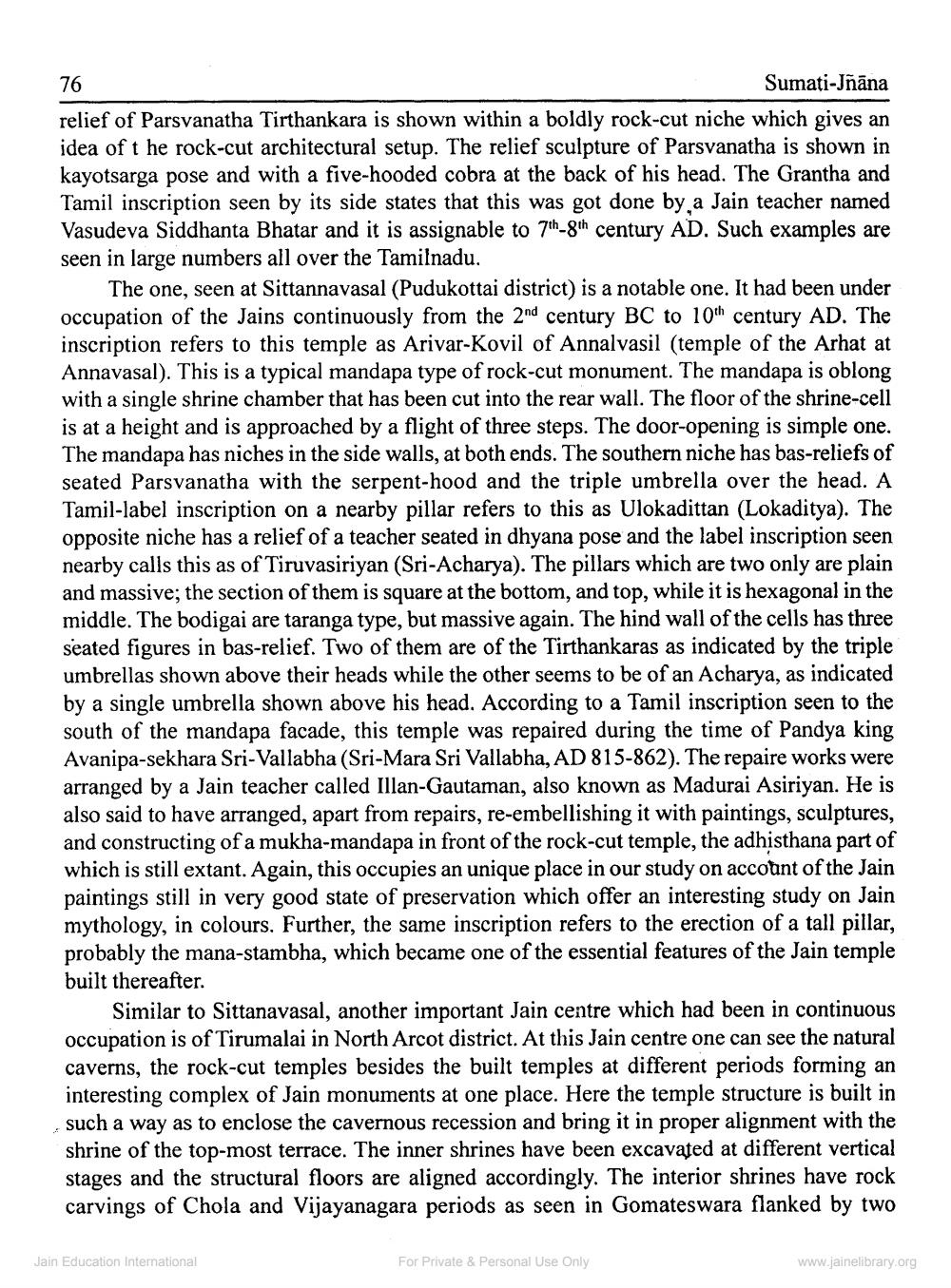________________
76
Sumati-Jñāna relief of Parsvanatha Tirthankara is shown within a boldly rock-cut niche which gives an idea of the rock-cut architectural setup. The relief sculpture of Parsvanatha is shown in kayotsarga pose and with a five-hooded cobra at the back of his head. The Grantha and Tamil inscription seen by its side states that this was got done by a Jain teacher named Vasudeva Siddhanta Bhatar and it is assignable to 7th-8th century AD. Such examples are seen in large numbers all over the Tamilnadu.
The one, seen at Sittannavasal (Pudukottai district) is a notable one. It had been under occupation of the Jains continuously from the 2nd century BC to 10th century AD. The inscription refers to this temple as Arivar-Kovil of Annalvasil (temple of the Arhat at Annavasal). This is a typical mandapa type of rock-cut monument. The mandapa is oblong with a single shrine chamber that has been cut into the rear wall. The floor of the shrine-cell is at a height and is approached by a flight of three steps. The door-opening is simple one. The mandapa has niches in the side walls, at both ends. The southern niche has bas-reliefs of seated Parsvanatha with the serpent-hood and the triple umbrella over the head. A Tamil-label inscription on a nearby pillar refers to this as Ulokadittan (Lokaditya). The opposite niche has a relief of a teacher seated in dhyana pose and the label inscription seen nearby calls this as of Tiruvasiriyan (Sri-Acharya). The pillars which are two only are plain and massive; the section of them is square at the bottom, and top, while it is hexagonal in the middle. The bodigai are taranga type, but massive again. The hind wall of the cells has three seated figures in bas-relief. Two of them are of the Tirthankaras as indicated by the triple umbrellas shown above their heads while the other seems to be of an Acharya, as indicated by a single umbrella shown above his head. According to a Tamil inscription seen to the south of the mandapa facade, this temple was repaired during the time of Pandya king Avanipa-sekhara Sri-Vallabha (Sri-Mara Sri Vallabha, AD 815-862). The repaire works were arranged by a Jain teacher called Illan-Gautaman, also known as Madurai Asiriyan. He is also said to have arranged, apart from repairs, re-embellishing it with paintings, sculptures, and constructing of a mukha-mandapa in front of the rock-cut temple, the adhisthana part of which is still extant. Again, this occupies an unique place in our study on account of the Jain paintings still in very good state of preservation which offer an interesting study on Jain mythology, in colours. Further, the same inscription refers to the erection of a tall pillar, probably the mana-stambha, which became one of the essential features of the Jain temple built thereafter.
Similar to Sittanavasal, another important Jain centre which had been in continuous occupation is of Tirumalai in North Arcot district. At this Jain centre one can see the natural caverns, the rock-cut temples besides the built temples at different periods forming an interesting complex of Jain monuments at one place. Here the temple structure is built in such a way as to enclose the cavernous recession and bring it in proper alignment with the shrine of the top-most terrace. The inner shrines have been excavated at different vertical stages and the structural floors are aligned accordingly. The interior shrines have rock carvings of Chola and Vijayanagara periods as seen in Gomateswara flanked by two
Jain Education International
For Private & Personal Use Only
www.jainelibrary.org




